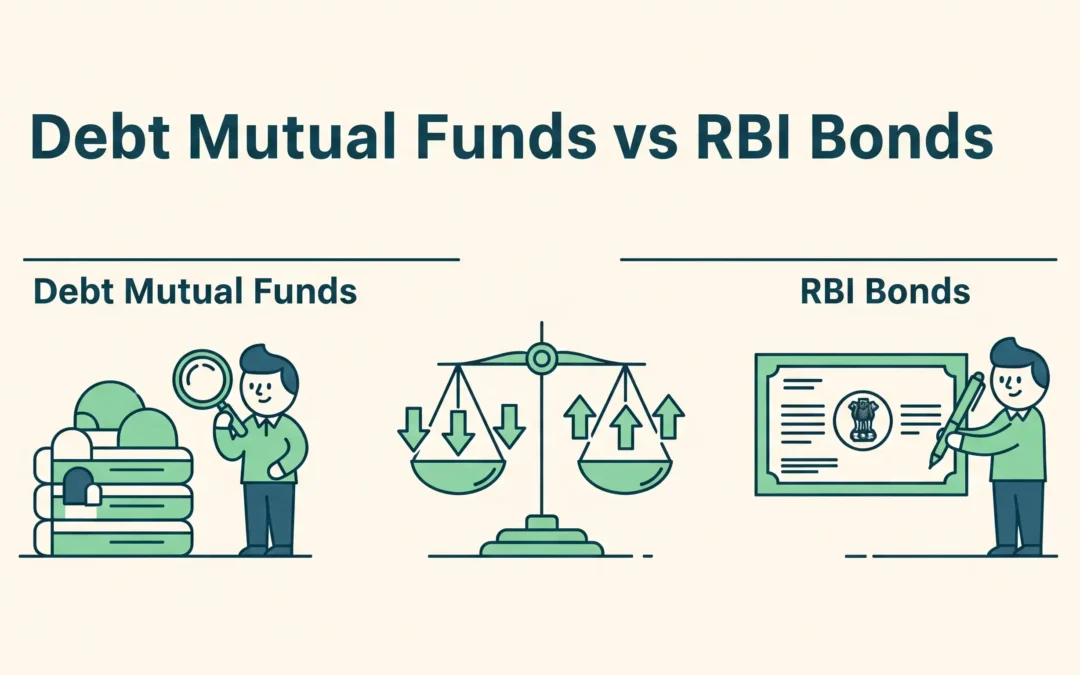Individuals invest their capital to generate wealth and earn returns. The goal is to increase the purchasing power of money over time by investing it in the right place. But, due to inflation, this goal is somewhat affected if the returns generated are on the lower side. Debt funds and RBI bonds are both low-risk investment options with decent returns. But do they beat inflation?
This article will help you understand the meaning of debt funds and RBI bonds, along with drawing a comparison between them and seeing if they beat inflation or not.
What Are Debt Funds?
Mutual funds that invest in fixed-income securities like corporate bonds, government securities, treasury bills, and other money market instruments are known as debt funds. Compared to equity funds, these funds seek to offer consistent, steady returns at a lower risk.
Key Features
- Stable Returns: comparatively less erratic than stocks.
- Diverse Options: Determined by returns, risk, and tenure.
- Market-Linked: Changes in interest rates could affect returns.
- Liquidity: T+1 or T+3 settlement makes redemption simple.
As an illustration, let’s say you invest Rs. 1 lakh in a short-term fund that yields an average 7% annual return. Your investment increases to about Rs. 1.07 lakh after a year, excluding taxes.
What Are RBI Bonds?
The Reserve Bank of India issues government-backed debt securities known as RBI Bonds. Conservative investors seeking stability and steady returns are the target market for these bonds. The Floating Rate Savings Bond (FRSB) is currently the most popular type.
Key Features:
- Sovereign Guarantee: supported by the Indian government.
- Fixed Return: Floating Return: Interest rates are currently set at 8.05%, but they are reset every six months based on the prevailing National Savings Certificate (NSC) rate plus a fixed spread.
- Lock-in Period: 7 years (only senior citizens may leave early).
- Taxable Interest: Depending on your income bracket, interest is fully taxable.
- No Market Risk: Returns are fixed and unaffected by the market.
For instance, you put Rs. 1 lakh into an RBI Floating Rate Savings Bond currently offering 8.05%. You would earn Rs. 4,025 in interest every six months, totaling Rs. 8,050 in a year, though this rate may change every six months.
Comparison Between: Debt Fund and RBI Bond
It’s crucial to comprehend how each investment performs under various economic circumstances, in addition to the numbers. For example, changes in interest rates have an impact on debt mutual funds. Bond prices increase when interest rates decline, which helps some debt funds, particularly gilt or long-duration funds.
In some cycles, this may yield higher returns than RBI bonds. They are subject to interest rate risk, though, and as rates rise, their performance may suffer. In contrast, RBI bonds prioritise capital stability over flexibility. While the interest rate is reset periodically by the RBI, investors benefit from the security of government backing and are not affected by daily market volatility or NAV fluctuations. You cannot redeem them before they mature unless you are a senior citizen who satisfies certain requirements, so this peace of mind comes at the expense of flexibility.
RBI bonds are suitable if you want steady government-backed returns and low risk, but after taxes, their ability to beat inflation is marginal. Short- to medium-duration debt funds may offer slightly higher potential for inflation-beating returns, but these too are limited after taxation and carry some market-linked risks.
You might also think about:
- Combining both choices to produce a low-risk hybrid income strategy.
- Using RBI bonds for guaranteed long-term income and debt funds for short-term objectives.
- Every year, you should review the tax implications and inflation to realign your fixed-income portfolio.
Let’s examine whether debt funds and RBI bonds can truly contribute to your financial growth. Let us assume an investment of Rs. 1,00,000
| Particulars | Debt Mutual Fund | RBI Floating Rate Bond |
| Investment Amount | Rs.1,00,000 | Rs.1,00,000 |
| Annual Return (pre-tax) | 8.5% | 8.05% |
| Amount Earned (1 year) | Rs. 8,500 | Rs. 8,050 |
| Tax Rate Assumed | 30% (slab rate) | 30% (interest taxable) |
| Tax Paid | Rs.2,552 | Rs.2,415 |
| Net Earnings (post-tax) | Rs. 5,950 | Rs. 5,635 |
| Total Value After 1 Year | Rs.1,05,950 | Rs.1,05,635 |
| Effective Post-Tax Return | 5.95% | 5.64% |
| Average Inflation Rate (assumed) | 5.5% | 5.5% |
| Real Return (adjusted for inflation) | +0.45% | +0.14% |
- Debt funds may yield marginally higher post-tax returns and offer superior liquidity.
- RBI Bonds are ideal for long-term, conservative investors because they guarantee stability and fixed income.
Bottomline
The conclusion is that the post-tax returns of both debt funds and RBI bonds are generally low and may only marginally keep up with inflation. While both are safe options—debt funds for liquidity and RBI bonds for stability—their real (inflation-adjusted, post-tax) returns are typically modest. RBI bonds are better suited for long-term investors, and conservative buyers prefer them more. Whereas, debt funds perform slightly better in beating inflation and are good for medium to short-term investments.
However, both are considered safe options, and investors should analyse their needs and then choose wisely.


